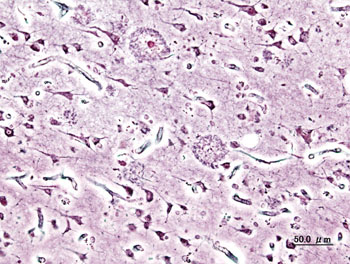Alzheimer's Disease Mouse Model Links Beta-Amyloid Deposits to Tau Protein Hyperphosphorylation
By LabMedica International staff writers
Posted on 14 Jul 2016
Neurodegenerative disease researchers have created a genetically engineered mouse model of Alzheimer's disease that is expected to facilitate the study of the molecular mechanisms that underlie the disorder.Posted on 14 Jul 2016
A central question in Alzheimer’s disease (AD) is whether the neuritic plaque is necessary and sufficient for the development of tau pathology. Hyperphosphorylation of all six tau protein isoforms can result in the self-assembly of tangles of paired helical filaments and straight filaments, which are involved in the pathogenesis of Alzheimer's disease and other tauopathies. When misfolded, this otherwise very soluble protein can form extremely insoluble aggregates that contribute to a number of neurodegenerative diseases.

Image: A silver impregnation histopathologic photomicrograph of neurite plaques in the cerebral cortex of a person with Alzheimer\'s disease (Photo courtesy of Wikimedia Commons).
Hyperphosphorylation of the tau protein has been demonstrated within neurites surrounding beta-amyloid deposits in AD mouse models, but the pathological conversion of tau was absent. Likewise, expression of a human tau repeat domain in mice was not sufficient to drive the pathological conversion of tau.
To develop a better understanding of how tau hyperphosphorylation was linked to beta-amyloid neuritis, investigators at Johns Hopkins University (Baltimore, MD, USA) genetically engineered an A-beta-amyloidosis mouse model that expressed the human tau repeat domain.
The investigators found that in these mice, the neuritic plaque facilitated the pathological conversion of wild-type tau. They showed that this tau fragment seeded the neuritic plaque-dependent pathological conversion of wild-type tau that spread from the cortex and hippocampus to the brain stem. These results established that in addition to the neuritic plaque, a second determinant was required to drive the conversion of wild-type tau.
"In Alzheimer's disease, tau bunches up inside the nerve cells and beta-amyloid clumps up outside these cells, mucking up the nerve cells controlling memory," said senior author Dr. Philip C. Wong, professor of pathology at Johns Hopkins University. "For the first time, we think we understand that the accumulation of amyloid plaque alone can damage the brain, but that is actually not sufficient to drive the loss of nerve cells or behavioral and cognitive changes. What appears to be needed is a second insult - the conversion of tau - as well."
Related Links:
Johns Hopkins University













